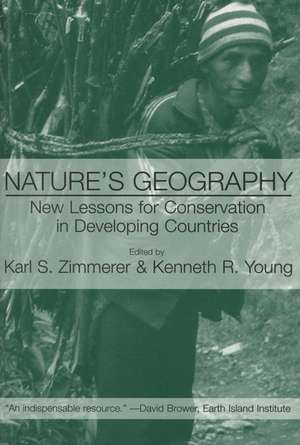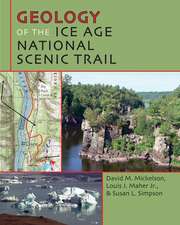Nature's Geography: New Lessons for Conservation in Developing Countries
Autor Karl S. Zimmerer Contribuţii de Kenneth R. Youngen Limba Engleză Paperback – 11 feb 1999
Developing countries in Africa, Asia, and Latin America are increasingly influenced by human-induced environmental changes. It is crucial that sustainable development be based on insights into these expanding processes—conservation as well as deterioration. Nature’s Geography offers a new perspective on the geographical nature of these changes. The book reveals how human-environment relations must be understood at multiple scales and time frames.
Editors Karl S. Zimmerer and Kenneth R. Young have forged an exciting group of case studies from distinguished geographers focusing on high mountains, tropical forests, and lowlands, as well as humid and arid-semiarid landscapes. Each chapter analyzes the implications for meshing environmental protection and sound resource use with development.
The case studies evaluate three topics: spatial habitat fragmentation and forest dynamics; disturbances in mountain ecosystems; and the major activities of settled areas, chiefly farming, livestock-raising, and forestry. Included are analyses of interactions involving wildlife, such as primates and wild pandas; assessment of fire impacts and road-building; long-term forest management as well as recent techniques; and the role of environmental variation and ecosystem properties in agriculture and rangeland.
Nature’s Geography demonstrates the vital importance of advancing a new approach to geography. This definitive study of landscape change and environmental dynamics will have wide appeal for those interested in geography, ecology, environmental studies, conservation biology, and development studies.
Editors Karl S. Zimmerer and Kenneth R. Young have forged an exciting group of case studies from distinguished geographers focusing on high mountains, tropical forests, and lowlands, as well as humid and arid-semiarid landscapes. Each chapter analyzes the implications for meshing environmental protection and sound resource use with development.
The case studies evaluate three topics: spatial habitat fragmentation and forest dynamics; disturbances in mountain ecosystems; and the major activities of settled areas, chiefly farming, livestock-raising, and forestry. Included are analyses of interactions involving wildlife, such as primates and wild pandas; assessment of fire impacts and road-building; long-term forest management as well as recent techniques; and the role of environmental variation and ecosystem properties in agriculture and rangeland.
Nature’s Geography demonstrates the vital importance of advancing a new approach to geography. This definitive study of landscape change and environmental dynamics will have wide appeal for those interested in geography, ecology, environmental studies, conservation biology, and development studies.
Preț: 169.35 lei
Nou
Puncte Express: 254
Preț estimativ în valută:
32.41€ • 35.19$ • 27.22£
32.41€ • 35.19$ • 27.22£
Carte disponibilă
Livrare economică 02-16 aprilie
Preluare comenzi: 021 569.72.76
Specificații
ISBN-13: 9780299159146
ISBN-10: 0299159140
Pagini: 272
Dimensiuni: 152 x 229 x 25 mm
Greutate: 0.5 kg
Ediția:New.
Editura: University of Wisconsin Press
Colecția University of Wisconsin Press
ISBN-10: 0299159140
Pagini: 272
Dimensiuni: 152 x 229 x 25 mm
Greutate: 0.5 kg
Ediția:New.
Editura: University of Wisconsin Press
Colecția University of Wisconsin Press
Recenzii
“The best hope for protecting and sustaining the earth rests in understanding the way it works, particularly the ways in which human activities shape the natural world. The geographers reporting here bring a special set of skills to their work. They show us how complicated, delicate, and enigmatic the interactions of people and nature can be, and how careful we must be in our tinkering if we want to keep celebrating a planet like this one.”—David R. Brower, Earth Island Institute
“This is a substantial and scholarly contribution by geographers to the biological conservation literature.”—Thomas T. Veblen, University of Colorado
Notă biografică
Karl Zimmerer is professor of geography at the University of Wisconsin–Madison and is the author of Changing Fortunes: Biodiversity and Peasant Livelihood in the Peruvian Andes. Kenneth R. Young is associate professor of geography at the University of Maryland, Baltimore County, and editor of Biogeografía, Ecología, y Conservación del Bosque Montano en el Perú.
Descriere
Developing countries in Africa, Asia, and Latin America are increasingly influenced by human-induced environmental changes. It is crucial that sustainable development be based on insights into these expanding processes—conservation as well as deterioration. Nature’s Geography offers a new perspective on the geographical nature of these changes. The book reveals how human-environment relations must be understood at multiple scales and time frames.
Editors Karl S. Zimmerer and Kenneth R. Young have forged an exciting group of case studies from distinguished geographers focusing on high mountains, tropical forests, and lowlands, as well as humid and arid-semiarid landscapes. Each chapter analyzes the implications for meshing environmental protection and sound resource use with development.
The case studies evaluate three topics: spatial habitat fragmentation and forest dynamics; disturbances in mountain ecosystems; and the major activities of settled areas, chiefly farming, livestock-raising, and forestry. Included are analyses of interactions involving wildlife, such as primates and wild pandas; assessment of fire impacts and road-building; long-term forest management as well as recent techniques; and the role of environmental variation and ecosystem properties in agriculture and rangeland.
Nature’s Geography demonstrates the vital importance of advancing a new approach to geography. This definitive study of landscape change and environmental dynamics will have wide appeal for those interested in geography, ecology, environmental studies, conservation biology, and development studies.
Editors Karl S. Zimmerer and Kenneth R. Young have forged an exciting group of case studies from distinguished geographers focusing on high mountains, tropical forests, and lowlands, as well as humid and arid-semiarid landscapes. Each chapter analyzes the implications for meshing environmental protection and sound resource use with development.
The case studies evaluate three topics: spatial habitat fragmentation and forest dynamics; disturbances in mountain ecosystems; and the major activities of settled areas, chiefly farming, livestock-raising, and forestry. Included are analyses of interactions involving wildlife, such as primates and wild pandas; assessment of fire impacts and road-building; long-term forest management as well as recent techniques; and the role of environmental variation and ecosystem properties in agriculture and rangeland.
Nature’s Geography demonstrates the vital importance of advancing a new approach to geography. This definitive study of landscape change and environmental dynamics will have wide appeal for those interested in geography, ecology, environmental studies, conservation biology, and development studies.










